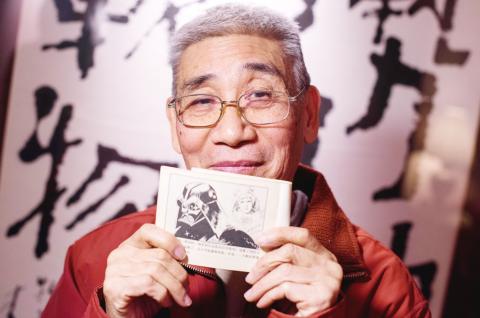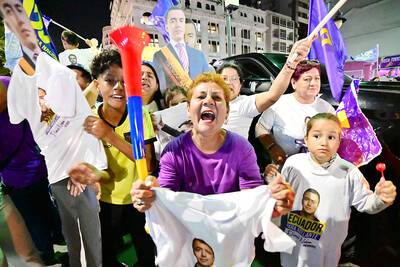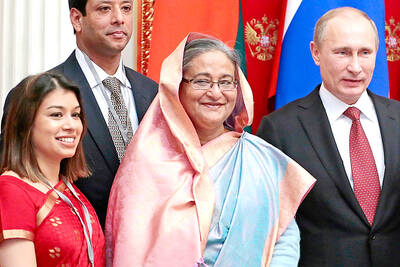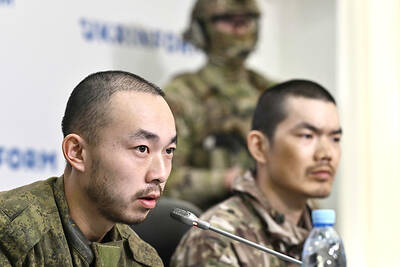A long time ago in a country far, far away, Chinese authorities managed to obtain a copy of the US’ ultimate cultural weapon, a blockbuster movie with enough special effects to wow an entire planet.
Summoned to a small theater in the southern city of Guangzhou in 1980, artist Song Feideng (宋飛等) was shown Star Wars and instructed to transform it into a traditional Chinese comic book, known as a lianhuanhua (連環畫), to promote scientific achievement.
Song was one of the first people in China to see George Lucas’ magnum opus, at a time when it was still banned — a marked contrast to the status of the series’ most recent installment in a market Hollywood increasingly sees as crucial to success.

Photo: AFP
“The objective was to take the world’s advanced science and popularize it in China,” said Song, who worked for a state-owned publisher at the time.
He replaced the movie’s X-wing fighters with Soviet rockets and jet fighters. In one illustration, Luke Skywalker wears a cosmonaut’s bulky spacesuit, while rebel leaders are dressed in Western business suits. Darth Vader appears alongside a Triceratops.
At the time, China was emerging from the isolation of the Mao Zedong (毛澤東) era and Star Wars had not been granted a release by the Chinese Communist Party, (CCP) three years after it hit Western cinemas.
The movie “was very novel, very exciting,” Song said, adding that he felt as if he had seen a “glimpse of the world.”
The project came amid a brief flowering of Chinese science fiction following Mao’s decade-long Cultural Revolution, when the arts were reduced to glorifying the CCP.
Mao’s decision to send intellectuals to work in the countryside had badly affected basic scientific research.
Song spent the period on the then poverty-stricken Hainan Island, producing propaganda slide shows.
Science fiction has had a fraught history in China.
Shortly after the 1977 US release of Star Wars, the People’s Daily attacked it as a fantasy that demonstrated how Americans’ “dissatisfaction with reality” had pushed them to “seek comfort in an illusory fairyland,” but the following year, as China began to reopen to the world, Beijing declared science fiction critical to rehabilitating the nation’s sciences, releasing a flood of almost 1,000 new titles.
A translated Star Wars script appeared in China as early as March 1979, while Song’s comic is believed to be the first illustrated standalone.
It sold briskly, he recalled.
“I could buy a TV, a stereo ... it was just unimaginable,” he said.
Hwoever, the initial hopes of the nation’s “reform and opening” quickly soured as artists began to criticize the government.
Speculative stories imagining a China without communism were not the plot lines authorities were looking for and they moved to ban science fiction again.
Song’s own works — he had moved into hard-boiled noir comics featuring private eyes, femme fatales and a keen appreciation for the female form — were criticized for “spiritual pollution.”
It was not until 1985 that Star Wars first appeared on Chinese screens, at a multicity US film festival that drew millions of viewers. By the late 1980s, it was airing on local television stations, while pirate copies circulated on video.
However, the movies never developed the broad, devoted fan base they have enjoyed elsewhere and most Chinese learned of the franchise through the prequels — much maligned in the West.
Song’s comic went viral ahead of the release of the latest installment, The Force Awakens, but a midnight premiere in Beijing this month had a mostly foreign audience.
Even so the movie raked in US$90 million in its first week, according to film data Web site China Box Office.
The world’s second-largest economy is also its second-biggest movie market and Hollywood is keen to satisfy its moviegoers, who have shown a deep appetite for Western science fiction, such as Avatar or the Transformers series.
However, Beijing has shown signs of resistance to that hunger, part of a wider pushback against the influence of “foreign culture.”
In 2011, the Chinese Administration of Radio, Film and Television issued an edict discouraging movies featuring “fantasy” and “time travel,” among other “bizarre plots.”
Chinese President Xi Jinping (習近平) has instructed artists to abandon “naive sensual amusement” and instead use “true-to-life images to tell people what they should affirm and praise.”
Song has split the difference — his most recent paintings of scantily-clad models incorporate CCP-friendly themes.
An illustration of a mostly naked woman, he says, symbolizes the beauty of the South China Sea. The traditional Chinese junk boat in the background, he adds, shows that the region has been Chinese since ancient times, echoing the party line on a bitter territorial dispute.
“As long as you don’t oppose the state, don’t oppose the Chinese Communist Party, there’s no problem with whatever you draw,” he said.

Incumbent Ecuadoran President Daniel Noboa on Sunday claimed a runaway victory in the nation’s presidential election, after voters endorsed the young leader’s “iron fist” approach to rampant cartel violence. With more than 90 percent of the votes counted, the National Election Council said Noboa had an unassailable 12-point lead over his leftist rival Luisa Gonzalez. Official results showed Noboa with 56 percent of the vote, against Gonzalez’s 44 percent — a far bigger winning margin than expected after a virtual tie in the first round. Speaking to jubilant supporters in his hometown of Olon, the 37-year-old president claimed a “historic victory.” “A huge hug

Two Belgian teenagers on Tuesday were charged with wildlife piracy after they were found with thousands of ants packed in test tubes in what Kenyan authorities said was part of a trend in trafficking smaller and lesser-known species. Lornoy David and Seppe Lodewijckx, two 19-year-olds who were arrested on April 5 with 5,000 ants at a guest house, appeared distraught during their appearance before a magistrate in Nairobi and were comforted in the courtroom by relatives. They told the magistrate that they were collecting the ants for fun and did not know that it was illegal. In a separate criminal case, Kenyan Dennis

A judge in Bangladesh issued an arrest warrant for the British member of parliament and former British economic secretary to the treasury Tulip Siddiq, who is a niece of former Bangladeshi prime minister Sheikh Hasina, who was ousted in August last year in a mass uprising that ended her 15-year rule. The Bangladeshi Anti-Corruption Commission has been investigating allegations against Siddiq that she and her family members, including Hasina, illegally received land in a state-owned township project near Dhaka, the capital. Senior Special Judge of Dhaka Metropolitan Zakir Hossain passed the order on Sunday, after considering charges in three separate cases filed

APPORTIONING BLAME: The US president said that there were ‘millions of people dead because of three people’ — Vladimir Putin, Joe Biden and Volodymyr Zelenskiy US President Donald Trump on Monday resumed his attempts to blame Ukrainian President Volodymyr Zelenskiy for Russia’s invasion, falsely accusing him of responsibility for “millions” of deaths. Trump — who had a blazing public row in the Oval Office with Zelenskiy six weeks ago — said the Ukranian shared the blame with Russian President Vladimir Putin, who ordered the February 2022 invasion, and then-US president Joe Biden. Trump told reporters that there were “millions of people dead because of three people.” “Let’s say Putin No. 1, but let’s say Biden, who had no idea what the hell he was doing, No. 2, and